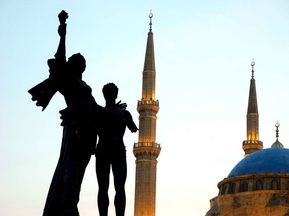
Although no more than a piece of concrete with a large number of parked cars on it, Martyrs Square is of big emotional importance. Until the early 20th century, the square was called Place des Canons, probably named after the large pieces of Russian artillery stationed there during the war with the Ottomans in 1771.
The square’s current name and its bronze statue refer to what happened there during the Arab Revolt against the Ottoman Empire: Over a period of two years of demonstrations, many Christians and Muslims (this time on the same side) were arrested and put in prison. During the final demonstration in 1916, the release of these prisoners was demanded, which made the Ottoman decide to bring all prisoners to the square. Instead of being released, the prisoners were hanged in front of the protesting people and this is how the new name was born. The French taking over the power from the Ottomans disagreed to this new name, and therefore it took until World War II for Martyrs Square to become the official name.
Currently it is the city’s most important place of protest, of which the 2005 demonstrations are probably the best example: After the murder on Rafiq Hariri on Valentine’s Day in 2005, protesters blaming Syria for the assassination clashed with the Lebanese army and a three-week anti-Syrian protest followed. As a response - presumably initiated by Hezbollah - 600,000 people gathered there on 8 March in order to show their support for Syria. This triggered the 14 March demonstration, a gathering of 1,000,000 citizens demanding the withdrawal of all Syrian military and security personnel. More recent examples are the protests at the day of the funeral of Wissam al-Hassan on 21 October 2012 and the protests demanding the government improve trash collection and management in the summer of 2015.

